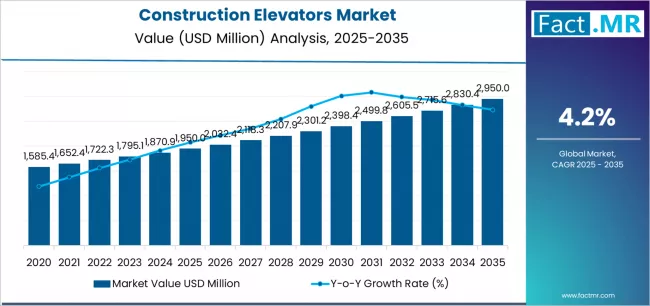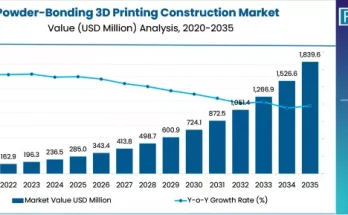As global construction activity accelerates, the demand for efficient vertical transportation solutions continues to rise. Construction elevators—also known as hoists or material lifts—play a critical role in moving personnel and materials safely across multiple building levels. They are indispensable on construction sites for high-rise buildings, infrastructure projects, and industrial facilities, where time efficiency and safety are top priorities.
Driven by rapid urbanization, infrastructure modernization, and growing investments in residential and commercial projects, the construction elevators market is entering a new phase of technological advancement and adoption. These machines are evolving from basic mechanical lifts into intelligent, energy-efficient systems that align with modern safety and sustainability standards.
Market Overview
The construction elevators market encompasses equipment designed to transport materials, personnel, or both within construction sites. These elevators are crucial for optimizing workflow, enhancing worker safety, and ensuring the smooth flow of operations at job sites with significant vertical requirements.
Construction elevators come in two major types: material hoists, which handle heavy loads like steel, concrete, and tools; and passenger hoists, which safely carry workers to elevated levels. Modern models often feature dual functionality, allowing simultaneous transport of people and materials—maximizing productivity in time-sensitive construction environments.
With advancements in engineering and design, manufacturers are introducing elevators equipped with frequency control systems, intelligent monitoring, and modular structures. These innovations improve efficiency, reduce power consumption, and enable smoother, vibration-free operation.
Regional Insights
The construction elevators market exhibits strong regional diversity, influenced by infrastructure development rates and construction technology adoption:
- North America remains a mature market, supported by high-rise construction in major cities and ongoing renovation of aging infrastructure. Safety compliance and rental-based demand are key market drivers in the region.
- Europe follows closely, with growth fueled by modernization projects, smart city developments, and stringent worker safety regulations. The region’s focus on energy-efficient equipment is shaping the design and deployment of modern construction elevators.
- Asia Pacific leads the global market in terms of growth potential. Expanding urban centers in countries like China, India, and Indonesia are driving large-scale residential and commercial construction, creating significant demand for high-performance hoists.
- Middle East & Africa benefit from ongoing megaprojects in countries such as Saudi Arabia and the UAE. Skyscrapers, stadiums, and infrastructure initiatives continue to boost the regional outlook for construction elevators.
This diverse regional demand underscores how global infrastructure development and modernization efforts sustain steady growth in the market.
Key Trends & Forecast
Several key trends are shaping the evolution of the construction elevators market:
- Integration of Smart Technologies: Advanced monitoring systems and IoT-enabled solutions are being adopted to track equipment health, load capacity, and operational performance in real time. These technologies reduce downtime and enhance site safety.
- Sustainability and Energy Efficiency: As construction companies work toward reducing carbon footprints, energy-efficient elevators equipped with regenerative drives and eco-friendly components are gaining traction.
- Modular and Customizable Designs: Manufacturers are focusing on creating modular hoist structures that can be quickly assembled, disassembled, and adapted to different building heights—offering flexibility for temporary and long-term projects.
- Focus on Safety Enhancements: With increasing global safety regulations, modern elevators now feature improved braking systems, overload protection, and emergency descent functions to ensure worker security.
- Rental and Leasing Growth: The preference for equipment rental over ownership continues to rise, particularly among small and mid-sized contractors. This trend allows firms to access advanced technology without incurring high upfront costs.
Together, these developments illustrate how the construction elevators market is transforming into a high-tech, service-oriented industry that aligns with the construction sector’s digital and environmental priorities.
Applications & End-Use Outlook
Construction elevators serve a wide range of end-use applications across the global construction ecosystem. Their versatility and load-bearing capacity make them essential for:
- Residential Construction: High-rise apartments and mixed-use complexes rely on passenger hoists for safe and rapid movement of workers, materials, and fixtures.
- Commercial Projects: Office towers, hotels, and retail complexes demand robust, high-capacity elevators to support continuous workflow and project efficiency.
- Infrastructure Development: From bridges to metro stations, infrastructure projects utilize heavy-duty hoists for transporting bulky materials and construction components.
- Industrial and Plant Construction: Manufacturing facilities and refineries often require custom-designed lifts for moving heavy equipment and structural assemblies during setup or maintenance.
- Renovation and Maintenance Works: Temporary elevator installations play a key role in building refurbishments and façade maintenance, ensuring efficient vertical access with minimal disruption.
By enabling safe and efficient vertical movement, construction elevators enhance overall project productivity, reduce manual labor, and minimize the risk of accidents.
Competitive Landscape
The construction elevators market features a mix of global and regional players offering a diverse range of equipment and services. Leading manufacturers are focusing on innovation, rental partnerships, and geographic expansion to strengthen their competitive position.
Companies are increasingly investing in digital control systems, lightweight materials, and automated safety mechanisms to differentiate their products. Furthermore, collaboration between OEMs and construction firms helps tailor elevator designs to project-specific requirements, improving usability and cost efficiency.
Aftermarket services—such as maintenance, inspection, and retrofit upgrades—are also emerging as critical components of long-term customer value strategies. This service-driven approach ensures reliability and compliance with safety standards throughout the equipment’s lifecycle.
Conclusion
Construction elevators have become indispensable in modern construction, bridging the gap between productivity, safety, and technology. As global urbanization continues and building designs reach new heights, the demand for efficient vertical transportation solutions will only intensify.
The market’s future lies in digitalization, safety innovation, and sustainability—areas that are redefining how construction equipment integrates into evolving infrastructure ecosystems. Organizations investing in modern, data-enabled elevator systems will not only enhance site efficiency but also contribute to safer and more sustainable construction practices.
In an industry defined by time, precision, and safety, the construction elevators market stands as a vital enabler of progress—lifting projects, people, and performance to new levels.
Browse Full Report – https://www.factmr.com/report/construction-elevators-market



